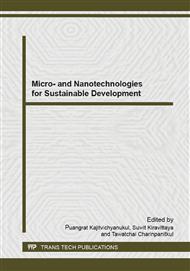[1]
C. Farrow, H. Wheeler, N. Bates, V. Murray, The chemical incident management handbook, London: The Stationery Office, (2000).
Google Scholar
[2]
Information on http: /www. cdc. gov/niosh/npg/npgd0049. html.
Google Scholar
[3]
Information on http: /www. atsdr. cdc. gov/toxprofiles/tp3-c7. pdf.
Google Scholar
[4]
H. Nguyen, S. A. El-Safty, Meso- and macroporous Co3O4 nanorods for effective VOC gas sensors, J. Phys. Chem. C 115 (2011) 8466–8474.
DOI: 10.1021/jp1116189
Google Scholar
[5]
J. Kong, N.R. Franklin, C. Zhou, M.G. Chapline, S. Peng, K. Cho, H. Dai, Nanotube molecular wires as chemical sensors, Science 687 (2000) 622-625.
DOI: 10.1126/science.287.5453.622
Google Scholar
[6]
W. Wongwiriyapan, S. I. Honda, H. Konishi, T. Mizuta, T. Ikuno, T. Ito, T. Maekawa, K. Suzuki, H. Ishikawa, K. Oura, M. Katayama, Single-walled carbon nanotube thin-film sensor for ultrasensitive gas detection, Jpn. J. Appl. Phys. 44 (2005).
DOI: 10.1143/jjap.44.l482
Google Scholar
[7]
C. Poonjarernsilp, N. Sano, T. Charinpanitkul, H. Mori, T. Kikuchi, H. Tamon, Single-step synthesis and characterization of single-walled carbon nanohorns hybridized with Pd nanoparticles using N2 gas- injected arc-in-water method, Carbon 49 (2011).
DOI: 10.1016/j.carbon.2011.07.016
Google Scholar
[8]
A. Ilcham, A. Srisurichan, A. Soottitantawat, T. Charinpanitkul, Dispersion of multi-walled carbon nanotubes in poly(p-phenylene) thin films and their electrical characteristics , Particuology 7 (2009) 403-407.
DOI: 10.1016/j.partic.2009.03.006
Google Scholar
[9]
J. Li, Y. Lu, Q. Ye, M. Cinke, J. Han, M. Meyyappan, Carbon nanotube sensors for gas and organic vapor detection, Nano Lett. 3 (2003) 929–933.
DOI: 10.1021/nl034220x
Google Scholar
[10]
E. S. Snow, F. K. Perkins, Capacitance and conductance of single-walled carbon nanotubes in the presence of chemical vapors, Nano Lett. 5 (2005) 2414–2417.
DOI: 10.1021/nl051669c
Google Scholar
[11]
W. Muangrat, R. Maolanon, S. Pratontep, S. Porntheeraphat, W. Wongwiriyapan, Polymer coated single-walled carbon nanotubes for ethanol and dichloromethane discrimination, Adv. Mater. Res. 802 (2013) 267-272.
DOI: 10.4028/www.scientific.net/amr.802.267
Google Scholar
[12]
I. Hafaiedh, W. Elleuch, P. Clement, E. Llobet, A. Abdelghani, Multi-walled carbon nanotubes for volatile organic compound detection, Sens. Actua. B 182 (2013) 344-350.
DOI: 10.1016/j.snb.2013.03.020
Google Scholar
[13]
R. Leghrib, A. Felter, F. Demoisson, F. Reniers, J.J. Pireaux, E. Loober, Room-temperature, selective detection of benzene at trace levels using plasma-treatmented metal-decorated multiwalled carbon nanotubes, Carbon 48 (2010) 3477-3848.
DOI: 10.1016/j.carbon.2010.05.045
Google Scholar
[14]
B. Zhang, R.U. Fu, M.Q. Zhang, X.M. Dong, P.L. Lan, J.S. Qiu, Preparation and characterization of gas-sensitive composites from multi-walled carbon nanotubes/polystyrene, Sens. Actua. B 109 (2005) 323-328.
DOI: 10.1016/j.snb.2004.12.066
Google Scholar
[15]
S.M. Cho, Y.J. Kim, Y.S. Kim, Y. Yang, S.C. Ha, The application of carbon nanotube-polymer composite as gas sensing materials, Sensors Proceeding of IEEE 2 (2004) 701-704.
DOI: 10.1109/icsens.2004.1426263
Google Scholar
[16]
H. Kataura, Y. Kumazawa, Y. Maniwa, I. Umezu, S. Suzuki, Y. Ohtsuka, Y. Achiba, Optical properties of single-wall carbon nanotubes, Synthetic Metals 103 (1999) 2555-2558.
DOI: 10.1016/s0379-6779(98)00278-1
Google Scholar
[17]
U.J. Kim, C.A. Furtado, X. Liu, G. Chen, P.C. Eklund, Raman and IR spectroscopy of chemically processed single-walled carbon nanotubes, J. Am. Chem. Soc. 127 (2005), 15437-15445.
DOI: 10.1021/ja052951o
Google Scholar
[18]
A. Garg, S.B. Sinnott, Effect of chemical functionalization on the mechanical properties of carbon nanotubes, Chem. Phys. Lett. 295 (1998) 273-278.
DOI: 10.1016/s0009-2614(98)00969-5
Google Scholar
[19]
A.A. Koos, Z.E. Horvath, Z. Osvath, L. Tapaszto, K. Niesz, Z. Konya, I. Kirisci, N. Grobert, M. Ruhle, L.P. Biro, STM investigation of carbon nanotubes connected by functional groups, Mater. Sci. Eng. C 23 (2003) 1007-1011.
DOI: 10.1117/12.498912
Google Scholar


